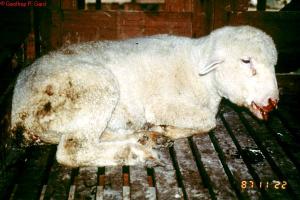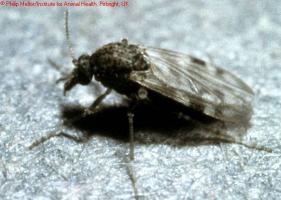Bluetongue
Names: Bluetongue
Description: Flies and mosquito borne disease
Host: Sheep (mostly British and Merinos), Cattle and Goats
Introduction
Bluetongue is a viral disease of domestic and wild ruminants and is transmitted by Midges (small flies, smaller than mosquitoes). Sheep are most severely affected but cattle and goats also become sick.
It is characterized by fever, swelling / inflammation of the nose, lips, tongue, gums and muzzle, muscle pain and lameness due to inflammation of the coronary band of the hoof (=where the hoof meets the skin of the leg).
The disease is common worldwide wherever conditions favour the survival of the Midges.
There are 24 different serotypes of Bluetongue viruses worldwide but not all types occur in one and the same geographical area. A sheep that is immune to one type of Bluetongue can still become sick from one of the other 23 types.
Bluetongue is a potentially very serious disease in sheep. The greatest loss sustained by the owner is an indirect one owing largely to the very marked loss in condition, the long recovery period and the break in wool, which are the inevitable results of an attack of Bluetongue. Many affected sheep remain in such a state of weakness following infection that many weeks or months of good feeding may be required before they regain condition. Awareness of this disease and how to combat it should be part of the armoury of every sheep farmer.
 |
| Sheep with Bluetongue disease |
|
© Geoffrey P. Gard. Reproduced from the Animal Health and Production Compendium, 2007 Edition. CAB International, Wallingford, UK, 2007
|
 |
| Female Culicuides Midges transmit Bluetongue disease |
|
© Philip Mellor
|
Mode of Spread
Bluetongue is spread by biting midges (small flies, called Culicoides), which is Culicoides imicola in Africa, Southern Europe and the Middle East. Mechanical transmission by other bloodsucking insects is over minor significance.
Infected Culicoides prefer warm, moist conditions and are highly nomadic, moving over vast distances thereby allowing the virus to spread over large areas.
Bluetongue is seasonal and occurs when the Midges /Culicoides are most active.
Cattle can act as carriers because the virus persists in the blood of cattle for up to 9 weeks. Most midges have a preference for cattle and will suck rather on cattle than on sheep when both species are housed together. But it is the sheep that become severely ill.
Sheep that survive Bluetongue become immune to the virus type that infects them, but they remain susceptible to the other Bluetongue virus types. Lambs from immune ewes can also become immune if infected early in life. Sheep of about one year of age are at the highest risk of suffering from Bluetongue. Cattle, when infected, mostly undergo hidden infections, not showing any disease.
Bluetongue can also cause abortions and birth of abnormal lambs due to virus infection during pregnancy.
British breeds of sheep and Merinos appear to be much more susceptible to Bluetongue than do native African sheep. But when African sheep that are normally kept in dry Culicoides free area are suddenly moved into a more humid Culicoides infected zone they can also become sick. Young sheep about a year old are most susceptible.
Exposure to a lot of sunshine seems to increase the severity of the disese.
Signs of Bluetongue
- The incubation period is about a week. Onset of illness is manifested by a high fever, which fluctuates for about a week.
- Together with the fever there is inflammation of the lips and nose, excessive salivation with licking of the lips and a clear nasal discharge. Within a few days the discharge contains mucous and pus and is bloodstained. It then dries, encrusting the nostrils.
- Meanwhile the lips swell and are very tender and bleed when handled. Sometimes a swollen, blue tongue is evident. The face swells. Deep ulcers, filled with white, dead debris appear at any site where there is irritation.
- Towards the end of the fever, lameness and stiffness develop. The lameness is due to inflammation at the coronary band of the hoof (where the hoof meets the skin of the leg), manifesting as a red or purplish band which travels down the hoof with the growth of horn. The stiffness is due to muscle pain. Severely affected animals lie down and will only move on their knees if forced.
- Twisting of the neck, may occur due to the direct effect of the virus on muscle tissue. After this, emaciation and weakness are rapid.
- Secondary infections of the respiratory tract are common and diarrhoea, often bloodstained, is sometimes seen.
- The mortality rate varies from 0 to 30%, although, in some epidemics it may reach 90%. Severely affected animals die within a week of the onset of fever, but others may linger on and only die after a month.
- Recovery in surviving sheep is prolonged and such animals frequently exhibit a moth-eaten appearance caused by breaks in the wool.
- The disease in cattle is frequently unapparent, although a few animals may develop signs similar to that seen in severely infected sheep. These include fever of 40°C to 41°C, stiffness, laminitis (damage to the sensitive tissue of the hooves), excessive salivation, swelling of the lips, loss of appetite, nasal discharge and a bad smelling breath. Ulcerative lesions may appear on the tongue, dental pad and muzzle. A severe inflammation of the coronet of the hoof may occur, sometimes with sloughing of the hoof. A discharge may appear at the nostrils and from the eyes. Wounds may occur on the teats.
- Infected goats show little in the way of clinical symptoms.
- Cattle and sheep infected during pregnancy may abort or deliver malformed calves or lambs.
Diagnosis
The history and clinical signs in sheep are highly suggestive and help in making a presumptive diagnosis.
Changes are very prominent in the mouth, where the mucous membranes (and the tongue) are full of blood and sometimes have a bluish discoloration. Discharge and flakes which are often covered with gray dead tissue are present on the lips, hard palate, cheeks and tongue. The nostrils are partly blocked by encrusted nasal discharge. The upper respiratory tract is inflamed and occasionally the lungs have fluid.
Exposed areas of skin have irregular encrusted eruptions.
In order to confirm the presumptive diagnosis a veterinary surgeon will take blood samples for analysis.
Diseases with similar symptoms
Bluetongue must be differentiated from other diseases which may have some symptoms in common. These include Foot and Mouth Disease, Sheep and Goat Pox and Orf in sheep and Foot and Mouth Disease, Ephemeral Fever, Sweating Sickness in cattle, and PPR/ Goat Plaque.
Prevention and Control
- Moving sheep during the rains to high, well-drained ground where there are no Midges/Culicoides will help to reduce the risk of infection.
- Midges are mostly active at dusk, dawn and at night. Smoke fires at night and use of insecticides when midges are very active have a role to play and housing cattle together with sheep on the grounds that Culicoides prefer cattle blood to sheep blood should be considered.
- Yearly vaccination of sheep with a live attenuated vaccine containing six strains of Bluetongue virus, available from KEVEVAPI, Nairobi, is recommended, and will do much to keep losses to a low level. It will not prevent the disease 100% as other strains of the virus not incorporated in the vaccine may be present in the locality.
- Lambs under three months should not be vaccinated nor should pregnant ewes, under normal circumstances.
Treatment
There are at presently no drugs which have a curative effect on Bluetongue. Antibiotics however, have a beneficial effect in combating secondary bacterial infections.
Careful nursing of affected animals is important. Affected animals should be placed in sheds or stables and protected from extreme temperature and from direct sunlight. Small quantities of soft green feeds should be given during the stage when mouth lesions make feeding painful.
Secondary invaders can be controlled by the application of lotions to the wounds. Careful and good feeding will reduce the duration of the recovery period and assist in re-establishing normal health in the sheep flock.
